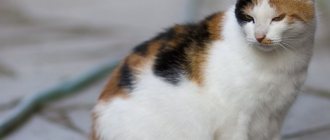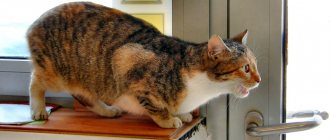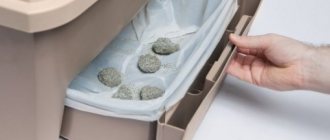Childbirth in a cat can occur with complications that cannot be predicted. Inexperienced owners often worry about their cat's condition if she takes too long to give birth. Let's figure out what interval between kittens can be considered normal and when it is better to seek urgent help from a veterinarian.
How to prepare for childbirth
A healthy female can give birth up to 5 times a year, so owners have to be careful to avoid accidental mating.
The question of how to find out when a cat lambs arises after a mating that happened without the knowledge of the owner. The owner needs to show her to the veterinarian to determine the timing of the birth of the offspring. Gestation lasts 9 weeks, preparation of the body begins in 7-10 days. You can find out that an important moment is approaching if you carefully monitor how the cat behaves before giving birth, as its habits change. She becomes restless and tries to hide. A characteristic sign of preparation is nesting syndrome, which is manifested by attempts to arrange a bed in a hard-to-reach place.
Feeding before birth
2-3 days before giving birth, the cat’s appetite worsens, which is considered normal. It is recommended to feed your pet 5-6 times a day in small portions. Remove foods that cause constipation/diarrhea from the diet and give liquid foods: broths, milk. Change the water frequently.
How to arrange a place
The birthing area is prepared in advance so that the pet gets used to it and knows where she will give birth to kittens. Otherwise, she will arrange the bed herself, choosing a secluded place under the sofa, bathroom or in the closet. Then it will be difficult for the owner to help the cat during childbirth.
How to prepare a place for a cat to give birth:
- Find a warm corner away from drafts and noise, where strangers, children, and pets have no access.
- Prepare a spacious box for mother and offspring.
- Cover the bottom with oilcloth, put a mattress on top, then moisture-absorbing diapers (not scented).
- Place bowls for food and water nearby, and a tray with filler not far from the box.
What to prepare from medicines, materials, tools
It is recommended to collect the first aid kit and auxiliary items in advance and keep it next to the box.
To give birth to a cat you will need:
- surgical gloves;
- syringes;
- sharp scissors with rounded ends;
- diapers (soft cotton fabric);
- sterile thread (preferably catgut from a veterinary pharmacy);
- 6-7 pcs. clean cotton towels for drying kittens;
- cotton swabs, sticks;
- pipette;
- sterile syringe with a rubber tip;
- a jar of water for placentas;
- petrolatum;
- alcohol, veterinary antiseptic solution (or brilliant green, hydrogen peroxide, iodine, chlorhexidine);
- antibiotic ointment;
- warmer;
- milk formula for newborn kittens (if the cat refuses to feed).
The following medications will be needed: Oxytocin , Sulfocamphocaine , sodium gluconate. Application and dosage should be agreed with your veterinarian. It is recommended to arrange a consultation or call with him in advance so that he can help the cat give birth at home.
Birth of the fetus
As soon as the kitten comes out, it is covered in a shell. The mother must carefully tear it apart and bite off the umbilical cord. The cat begins to intensively lick the baby, which helps clear his respiratory tract of mucus. The kitten should squeak - this is a sign that it is breathing. After or along with the kitten, the placenta comes out, which the mother can eat. If the offspring is large, you should not let her eat more than 3 afterbirths.
You need to make sure that all traces come out. Their number should correspond to the number of fruits. The placenta remaining inside can cause serious inflammatory diseases.
In the intervals between births, it is necessary to ensure that the mother does not lie on the newborn kitten. Due to the pain and discomfort, she may not notice it and accidentally press it down.
We suggest you read: Is it possible to cross a fold-eared cat with a fold-eared cat: why not?
When all the babies are born, it is necessary to organize complete peace for the family. The mother will lick and feed her babies, so there is no need to disturb them too much. If a cat has eaten the afterbirth, she may not eat for several hours after giving birth. It is necessary to leave her something to drink and place a toilet nearby so that she does not go far from the offspring.
How to understand that labor has begun
Symptoms of impending labor appear within 1-2 hours. The owner should stay close to the animal to monitor whether the water breaks.
Harbingers (signs) that a cat will give birth soon:
- loss of appetite, cat drinks often;
- you can see how the kittens move in their stomachs;
- there is discharge from the perineum, which the cat licks;
- nipples are swollen, colostrum appears when pressed;
- rectal temperature decreased to 37 °C;
- lethargic behavior: the cat is apathetic before giving birth and does not leave the box;
- 4-6 hours before lambing, false contractions develop;
- within 1-2 hours the birth plug comes out, then the waters pour out.
Childbirth: how long should it last in theory and in practice
We are interested in the first stages of childbirth, at the moment of which the offspring are born. Immediately after the stage accompanied by a decrease in general body temperature, the main stage of the birth process begins. During this period, the cat begins to become very worried and nervous (this is especially true for primiparous animals).
You may notice shortness of breath, a sudden increase in your pet's activity, or a refusal to eat. In rare cases, vomiting is observed (but during normal labor it is quite rare). The cat also exhibits "nesting" behavior. Once again, show your pet the box or basket in which she should give birth. Talk to the animal, stroke it, calming it down. Sometimes placing some old clothes in the basket, saturated with the owner's scent, helps. This “aromatherapy” calms many cats, as a result of which the pet no longer tries to escape and give birth on your bed.
So, the first stage normally lasts from 6 to 12 hours . During this period, the cervix should fully dilate and relax. In cases where, after 24 hours, no signs of the onset of labor appear, we strongly advise you to seek help from a veterinarian.
How does a cat give birth?
The timing of lambing varies depending on the breed. In veterinary practice, the end of pregnancy on the 65th day is considered the norm, and premature births are those that occur before the 60th day. No one will give a specific answer to the question of how long it takes a cat to give birth. The duration and nature of childbirth depend on the physical condition, age, presence of illnesses, and injuries.
How do contractions go?
4-6 hours before real birth, false (training) contractions develop. They prepare the kittens for exit from the womb, and the uterine vascular system for contraction of the organ after labor is completed to prevent bleeding.
You can tell that a cat is going into real labor by looking at its behavior. The animal arches, strains, screams. Then comes a period of rest. The intensity of contractions increases, the rest time between them decreases, and the size of the perineum increases.
How do kittens appear?
About an hour before the birth of the firstborn, mucus is secreted from the cat’s vagina, facilitating passage through the birth canal. The fetus comes out after 3-5 contractions while pushing head first. Further, the interval between kittens ranges from 5 to 30 minutes, but can last up to 1 hour.
How does the afterbirth come out?
Owners giving birth for the first time may not know what the placenta looks like. This is the placental sac (vesicle, baby's place) in which the fetus developed during pregnancy. During normal delivery, the membrane separates from the fetus and exits the birth canal immediately after the kitten or after a couple of minutes.
If the placenta (or part) remains inside the body, it means that the birth is complicated. Therefore, it is important to monitor the number of newborns and placentas. The number of kittens a cat gives birth to is the number of shells that must come out. If the baby's place stays inside for more than 3 hours after the end of labor, intervention (surgery) is required, otherwise internal inflammation will develop.
Duration of labor
The first lambing in nulliparous cats lasts longer than subsequent ones. The beginning is considered to be the appearance of frequent contractions, the end is the release of the last fetus. How long labor lasts depends on many factors. The norm is 12-18 hours. If lambing continues for more than 24 hours, veterinary assistance is required. If the cat cannot give birth for more than 2 days, a cesarean section is performed.
How many kittens can be born?
The average number of individuals in a litter is 3-8. Young cats bear 1-3 kittens, since the reproductive system is not fully formed. The same offspring are produced by older individuals, since reproductive function fades with age. Otherwise, it is impossible to predict without an ultrasound how many kittens a cat can give birth to.
Appearance of healthy newborn kittens
Babies are born helpless, with closed eyes, ear canals, and toothless. The coat is thin, there is no undercoat. The average weight of babies is 80-110 g, length – 9-12 cm, temperature – 36.1 °C.
Healthy kittens have a well-developed sense of smell and touch. They immediately find and apply to the mother's nipples.
How to understand that labor is over
If, after the birth of the next kitten, the cat remains in place, refuses to drink and eat, and reluctantly licks the offspring, it means that lambing is not completed.
Other signs will also help you understand that your cat has finished giving birth:
- more than 40 minutes have passed since the last calf emerged;
- the abdomen is soft, no lumps are detected when palpated;
- breathing is smooth, cardiac activity is normal;
- the animal changes its body position and leaves the box;
- actively cares for offspring;
- appetite appeared.
It can sometimes be difficult to understand that a cat has given birth to all her kittens. However, it is necessary to make sure of this so as not to miss the inflammatory process due to the fetus remaining inside.
The main signs of the end of labor
When a cat gives birth, it is important to make sure everything is successful in the end. This can be judged by the presence of the following signs:
- As soon as the mother realizes that all the kittens are out, she begins to actively care for the offspring, feeding them milk. At the same time, the cat intensively licks the babies, feeds them, purrs;
- If you listen to your breathing, you will find that it is even. Heart beats and pulse are rhythmic and follow at a normal speed;
- Mom eats and drinks with pleasure;
- the pet is able to get up and walk at least a little;
- when labor ends, if palpation is done no earlier than 40 minutes later, the abdomen will feel soft and relaxed to the touch. When palpating, you cannot feel the presence of seals. The muscles may be tense for a short period of time, but this quickly passes.
An indirect sign of a favorable end of labor may be the natural and calm behavior of the pet. However, it is normal for some cats to remain calm even when giving birth.
Pathological birth
The risk of complications always exists, so the owner should monitor changes in the pet’s behavior. Then he will be able to help the cat during childbirth.
Non-psychological factors of complicated labor include:
- Mechanical blockade. Occurs when the size of the fetus exceeds the diameter of the birth canal, and contractions are too weak to push it through. The second reason for difficult childbirth in cats is incorrect presentation of the fetus (sacrum or tail forward).
- Atony of the uterus. Sluggish contractions occur due to stretching/expansion of the uterus, multiple pregnancies, dropsy, lack of oxytocin and/or calcium in the body.
If the fetus is stuck in the birth canal, then the owner needs to put on a glove and lubricate it with Vaseline. Carefully insert your fingers inside and grab the kitten by the withers. You can’t pick it up by the paws: they can be dislocated or broken. Carefully remove the fruit using smooth rocking movements.
A doctor's help will be needed if a dark, foul-smelling fluid is released from the cat's birth canal, the intervals between contractions have increased, or labor has been prolonged.
What to do when kittens are stillborn
If offspring appear without signs of life, resuscitation will be required. If the efforts made are ineffective, the corpses should be removed from the box and placed in separate bags. After birth, the cat should be taken for postmortem analysis to determine the cause of death.
What to do when newborn kittens are not breathing
If the kitten is lifeless and the mother is indifferent to it, the owner needs to carry out resuscitation actions:
- Turn the kitten head down and, holding it, shake the body so that liquid flows out of the mouth and lungs. Suck out the remainder with a syringe.
- Blow 2-3 times into your nose and mouth (not too much, otherwise your lungs will be damaged).
- Check your heartbeat. If absent, begin resuscitation: rhythmically compress the chest with your index finger and thumb at heart level. Press quickly, but not hard. Blow air into the kitten's nostrils every 15-20 seconds. If a heartbeat appears, stimulate the rhythm: turn the body over, take the baby by the withers, dry him with a towel. It may take a couple of repetitions of resuscitation to get the kitten to breathe.
The duration of cardiopulmonary stimulation is 20 minutes in the presence of a heartbeat. If the kitten does not breathe within 5 minutes of the procedures, you will have to accept death.
Actions during complicated childbirth
If the owner notices that something is going wrong during the birth process, he must immediately intervene and provide first aid to the animal. Or immediately contact a veterinary clinic. It is better to have on hand several phone numbers of veterinarians who can conduct a remote consultation.
Signs of developing complications are:
- The cat's contractions have stopped. If contractions stop while the fetus is passing through the birth canal, you should lubricate the genitals with Vaseline to make it easier for it to come out (the procedure is performed with sterile rubber gloves). Stroke the belly towards the vulva. If labor has stopped, and the fetus is still clearly felt in the stomach, you should inject the animal into the withers with oxytocin (a hormone that stimulates the functioning of the uterus) in a dosage of 0.2 ml. It is recommended to seek help from a veterinarian, since the remaining litter inside can lead to the death of the animal.
- There is mucous discharge with an unpleasant odor, or bleeding. You should immediately go to a veterinary hospital, since inflammatory processes (as evidenced by discharge) or uterine bleeding without appropriate treatment will lead to the death of the animal.
- Suspicion of eclampsia (critical decrease in calcium levels), accompanied by convulsions. For 3 days you will need to inject calcium gluconate at a dosage of 1 ml.
- Preservation of placenta in the womb. It is necessary to inject oxytocin and go to the veterinary clinic if after the injection the placenta does not come out.
- Frozen pregnancy. In this case, the animal will require a cesarean section. Most often it is performed using a radical method with complete removal of the uterus.
A newborn kitten may also need help. If the mother for some reason refuses to undergo all the procedures necessary for him, this must be done by a person. The mother may not lick the kitten or release it from the bladder. In this case, you need to carefully cut the bubble with sterile scissors and wipe the baby with a clean, soft towel.
A newborn kitten must be placed with its mother. If she ignores him, then the owner should take care of him. In the future, the baby needs to be provided with warmth and safety. These kittens are fed using a pipette with a special mixture for newborns.
When is labor induction needed?
It is up to the veterinarian to decide what to do if the cat cannot give birth. Otherwise, an incorrectly determined reason for the delay in birth will lead to complications or death of the pet.
Stimulation is carried out when there is a prolonged interval between the birth of kittens (1-3 hours) or late lambing. Before inducing labor in a cat, you need to make sure that the measures taken will not harm her.
Stimulation of the uterus begins with a gentle massage of the abdomen and nipples. The administration of oxytocin is used in emergency cases, if it is established that there is no mechanical blockade. The decision to give an injection is made by the doctor, since an incorrect dose of the administered medication will cause rupture of the cervix, death of the kittens and/or the mother in labor.
If not all babies are born, what should I do?
If your cat’s labor suddenly takes too long, you don’t need to immediately think about the bad. But it’s also not worth waiting until everything resolves itself. The first birth can be very long. If there are many kittens in the womb, the process may also take longer. But how can you tell if all the babies have come out? What if 1 or 2 are left inside, and the animal is not going to continue labor? So, when an owner should be wary:
- The cat has strange behavior.
- If you palpate the abdomen, you will notice a lump in it approximately the size of a kitten.
- The cat's tummy does not "deflate".
- The temperature increased to 39 degrees.
- Greenish discharge appeared from the vagina.
It also happens that a mother simply decides to “rest” a little, having already produced 4-5 babies. And during the break, the cat calmly goes about her maternal business: licking the kittens, feeding them, eliminating the remains of the placenta. If the cat looks calm and content, everything is fine; after some time, the remaining kittens will definitely be born.
But if one or more of the above symptoms are present, then having kittens in the womb can lead to big problems. The owner who notices something is wrong should urgently call a specialist. Every minute is worth it. Not only unborn kittens are at risk, but also the cat herself.
What happens to a cat after giving birth?
The mother needs time to recuperate after lambing. It is necessary to monitor her condition so as not to miss alarming symptoms.
Normal state
For the first 5-7 hours (sometimes 24 hours), the mother may refuse to eat, which is considered normal if she actively laps up water. Trips to the litter tray may be suspended temporarily (up to 4 days). It is also possible for pink discharge to appear in the first 7 days after birth.
As for when a cat begins to produce milk, the norm is immediately after birth, when the first-born kitten begins to suckle. Minor delays due to stress are acceptable. After a short time, the cat will calm down and lactation will improve. Next, it is necessary to provide the woman in labor with peace, fresh food, and drink so that the milk does not disappear.
Signs of complications
Deterioration of condition after lambing is more often observed in very young, injured and purebred individuals. Domestic cats that are constantly in the fresh air and actively moving have stronger bodies, so difficult childbirth is practically excluded.
Pet owners need to monitor behavior to spot adverse symptoms early.
You should consult a doctor if you experience any of the following symptoms:
- the cat is anxious, restless or apathetic;
- no appetite for more than 24 hours;
- body temperature changed sharply: increased to 39.4 °C or fell below 36.1 °C;
- bleeding continues for more than 10 minutes;
- milk of abnormal color and/or consistency (yellowish, transparent, curdled);
- persistent vomiting and/or diarrhea;
- paws and/or head trembling;
- purulent or foul-smelling discharge within 3 weeks after birth;
- nipples are very hot and swollen;
- The cat doesn't care about kittens.
In females with very large offspring, milk fever (eclampsia) may develop due to a sharp decrease in calcium concentration in the body.
Signs of pathology in a cat:
- anxiety;
- rapid breathing;
- pallor of the mucous membranes;
- lack of coordination of movements;
- pointed muzzle with exposed fangs;
- temperature jump to 41.1 °C;
- convulsions, loss of consciousness.
Organization of the “family nest”
On average, pregnancy in cats lasts 65 days. The period may vary from 60 to 70 days. Childbirth before and after this period can be caused by pathologies (impaired pregnancy, fetal death, etc.) and be accompanied by complications. Therefore, it is important to closely monitor the condition of the animal during pregnancy, and especially in the last stages. After the 60th day of pregnancy, it is necessary not to leave the cat alone for a long period of time, so as not to miss the onset of labor.
Childbirth is a natural process. Sometimes it causes even more stress for the owner than for the pet itself. The cat's instincts will allow her to perform all the necessary manipulations, however, a person should monitor the process and intervene only if necessary.
Before the birth itself, it is important to provide the animal with an appropriate place. The cat itself will look for a secluded corner and spend a lot of time there. Sometimes the animal is huddled in the farthest and darkest corners, to which there is no access, and in an emergency it will not be possible to quickly provide help. Therefore, it is better to organize a “family nest” yourself.
The place should be cozy, spacious enough, and located in a quiet and peaceful part of the house. It should be remembered that the mother and offspring will spend the next few weeks here, and at first they will not be disturbed.
Caring for cats and kittens after birth
The box should be cleaned and soiled diapers replaced with clean ones. Place the box with the family in a quiet place. Observe behavior: if there was a simple birth, without complications, then the mother is calm, focused on licking and feeding the children. To eliminate stress and cessation of lactation, you will have to temporarily limit the visits of guests.
Further care for the cat that has given birth comes down to ensuring cleanliness and nutrition. It is recommended to keep the tray and bowls close to the box so that the mother is close to the offspring. Feed 5 times a day, give vitamins for newborn cats.
The cat gives birth too quickly
When kittens are born too quickly, the birth is called precipitate. Note that rapid labor is more dangerous than prolonged labor, although it passes much faster. Usually, with rapid labor, all kittens are born in less than 1 hour.
The cause of rapid labor may be stress or miscarriage. In rare cases, rapid labor is a hereditary factor. When labor progresses too quickly, the cat experiences severe pain as the intervals between contractions become shorter. Hormones are released into the animal's blood, allowing the cervix to dilate as quickly as possible and expel the litter.
In rapid labor, kittens are born literally one by one, the cat does not pay attention to licking the babies, often does not gnaw the umbilical cord, but can eat the placenta...or the kittens themselves. This picture indicates the non-viability of the offspring, which often occurs during a miscarriage. Your task is to open the bubbles as quickly as possible, remove liquid from the kittens’ respiratory tract and wipe them with towels.
Some cats, even after a rapid birth (if the kittens survive), accept and begin to feed the babies. Wait until the pet comes to its senses a little and try placing the kittens on the nipples. Carefully monitor your cat's behavior; if she growls and hisses when she hears kittens squeaking, do not try to place them under her nipples! The only way out in this case is artificial feeding... but you must understand that the kittens' chances of survival are minimal.











